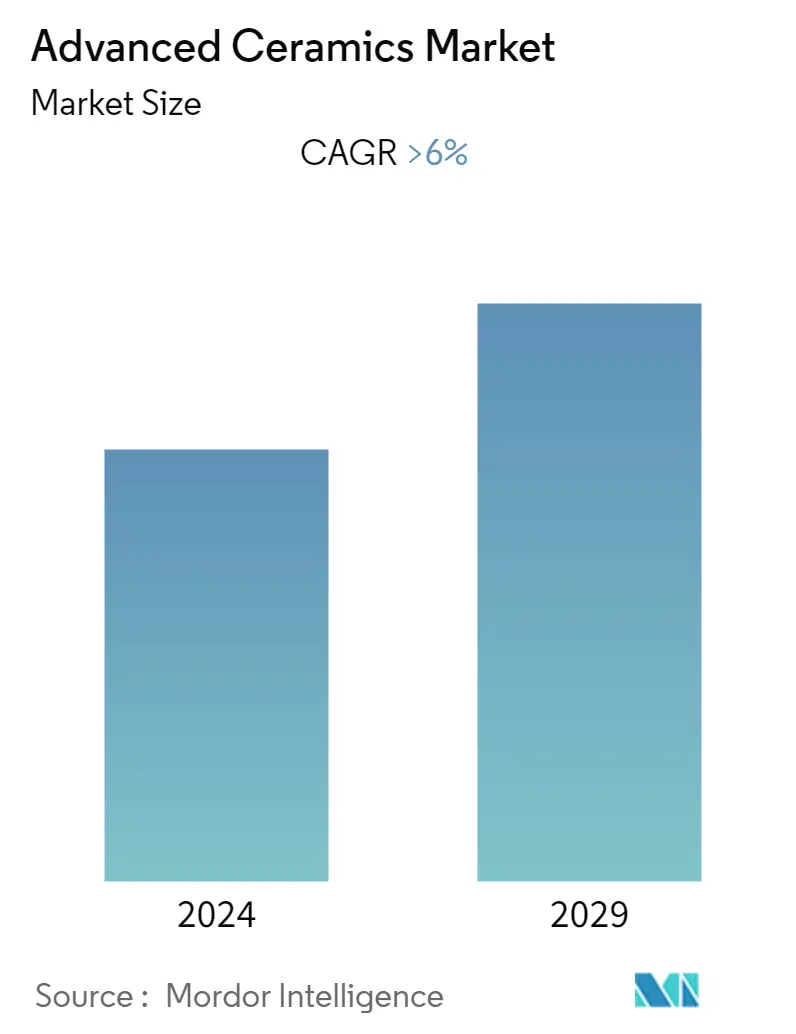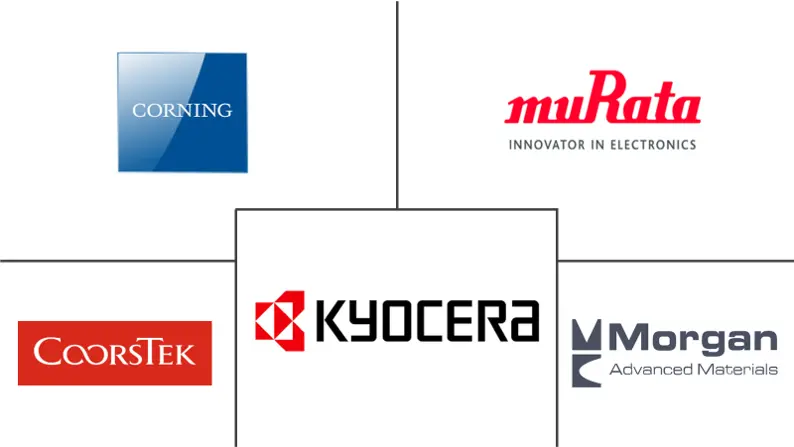Market Size of Advanced Ceramics Industry

| Study Period | 2019 - 2029 |
| Base Year For Estimation | 2023 |
| CAGR | 6.00 % |
| Fastest Growing Market | Asia-Pacific |
| Largest Market | Asia-Pacific |
| Market Concentration | Medium |
Major Players
*Disclaimer: Major Players sorted in no particular order |
Advanced Ceramics Market Analysis
The advanced ceramics market is expected to register a CAGR of over 6% during the forecast period (2022-2027).
- The impact of the Covid-19 pandemic on the market was largely negative, but the market has now reached pre-pandemic levels and is expected to grow steadily during the forecast period.
- Over the medium term, the major factors driving the market are the rise in use as an alternative to metals and plastics and the growing demand in the medical industry.
- On the flip slide, high capital investment for the equipment and chemical processes and uncertainty in regulative policies concerning climate change, energy & environment undermine the market.
- However, increasing applications of silicon carbide (SiC), gallium nitride (GaN), and growth in usage in nanotechnology would likely create lucrative growth opportunities for the global market soon.
- The electronics and electrical industry dominated the market, and it is expected to grow during the forecast period, owing to a wide range of electrical properties of advanced ceramics, including insulating, semiconducting, superconducting, piezoelectric, and magnetic properties.
- Asia-Pacific dominated the market globally, with the largest consumption from countries such as China and Japan.
Advanced Ceramics Industry Segmentation
The advanced ceramics market is segmented by material type, class type, end-user industry, and geography. By material type, the market is segmented into alumina, titanate, zirconia, silicon carbide, aluminum nitride, silicon nitride, magnesium silicate, pyrolytic boron nitride, and other material types. By class type, the market is segmented into monolithic ceramics, ceramic matrix composites, and ceramic coatings. By end-user industry, the market is segmented into electrical and electronics, transportation, medical, industrial, defense and security chemical, and other end-user industries. The report also covers the market size and forecasts in 15 countries across major regions. The market sizing and forecasts for each segment have been calculated based on revenue (USD million).
| Material Type | |
| Alumina | |
| Titanate | |
| Zirconia | |
| Silicon Carbide | |
| Aluminum Nitride | |
| Silicon Nitride | |
| Magnesium Silicate | |
| Pyrolytic Boron Nitride | |
| Other Material Types |
| Class Type | |
| Monolithic Ceramics | |
| Ceramic Matrix Composites | |
| Ceramic Coatings |
| End-user Industry | |
| Electrical and Electronics | |
| Transportation | |
| Medical | |
| Industrial | |
| Defense and Security | |
| Chemical | |
| Other End-user Industries |
| Geography | |||||||
| |||||||
| |||||||
| |||||||
| |||||||
|
Advanced Ceramics Market Size Summary
The advanced ceramics market is poised for steady growth, driven by its increasing use as an alternative to metals and plastics, alongside rising demand in the medical industry. Despite the initial negative impact of the Covid-19 pandemic, the market has rebounded to pre-pandemic levels. Key challenges include high capital investment requirements and regulatory uncertainties related to climate change and environmental policies. However, the market is expected to benefit from the expanding applications of silicon carbide and gallium nitride, as well as advancements in nanotechnology. The electronics and electrical industry remains a dominant sector, leveraging the diverse electrical properties of advanced ceramics, such as insulating and semiconducting capabilities. The Asia-Pacific region leads in market consumption, with significant contributions from China and Japan.
In the electrical and electronics sector, silicon carbide is anticipated to have substantial applications, particularly in electric vehicles and high-power devices. Aluminum nitride, silicon nitride, and boron nitride are also utilized for their thermal and electrical properties. Asia-Pacific's prominence in global electronics manufacturing is underscored by its substantial production share, with countries like South Korea, Vietnam, India, and China at the forefront. Europe, particularly Germany, also plays a significant role, with its electronics industry contributing notably to industrial production. Japan's electronics industry is a global leader, with a strong focus on consumer electronics and key components. The advanced ceramics market is characterized by partial fragmentation, with major players like Kyocera Corporation and Corning Incorporated holding significant market shares. Recent developments include CeramTec's collaboration with the Fraunhofer Institute for Integrated Systems and Device Technology to create ceramic power modules for e-mobility solutions, and CoorsTek's establishment of a new manufacturing facility in Southeast Asia.
Advanced Ceramics Market Size - Table of Contents
-
1. MARKET DYNAMICS
-
1.1 Drivers
-
1.1.1 Rise in Use as Alternative to Metals and Plastics
-
1.1.2 Growing Demand in the Medical Industry
-
1.1.3 Eco-friendliness and Reliability of Use
-
-
1.2 Restraints
-
1.2.1 Unfavorable Conditions Arising due to COVID-19 Impact
-
1.2.2 Other Restraints
-
-
1.3 Industry Value Chain Analysis
-
1.4 Porter's Five Forces Analysis
-
1.4.1 Bargaining Power of Suppliers
-
1.4.2 Bargaining Power of Consumers
-
1.4.3 Threat of New Entrants
-
1.4.4 Threat of Substitute Products and Services
-
1.4.5 Degree of Competition
-
-
1.5 Patent Analysis
-
1.6 Price Analysis
-
-
2. MARKET SEGMENTATION (Market Size in Value)
-
2.1 Material Type
-
2.1.1 Alumina
-
2.1.2 Titanate
-
2.1.3 Zirconia
-
2.1.4 Silicon Carbide
-
2.1.5 Aluminum Nitride
-
2.1.6 Silicon Nitride
-
2.1.7 Magnesium Silicate
-
2.1.8 Pyrolytic Boron Nitride
-
2.1.9 Other Material Types
-
-
2.2 Class Type
-
2.2.1 Monolithic Ceramics
-
2.2.2 Ceramic Matrix Composites
-
2.2.3 Ceramic Coatings
-
-
2.3 End-user Industry
-
2.3.1 Electrical and Electronics
-
2.3.2 Transportation
-
2.3.3 Medical
-
2.3.4 Industrial
-
2.3.5 Defense and Security
-
2.3.6 Chemical
-
2.3.7 Other End-user Industries
-
-
2.4 Geography
-
2.4.1 Asia-Pacific
-
2.4.1.1 China
-
2.4.1.2 India
-
2.4.1.3 Japan
-
2.4.1.4 South Korea
-
2.4.1.5 Rest of Asia-Pacific
-
-
2.4.2 North America
-
2.4.2.1 United States
-
2.4.2.2 Canada
-
2.4.2.3 Mexico
-
-
2.4.3 Europe
-
2.4.3.1 Germany
-
2.4.3.2 United Kingdom
-
2.4.3.3 Italy
-
2.4.3.4 France
-
2.4.3.5 Rest of Europe
-
-
2.4.4 South America
-
2.4.4.1 Brazil
-
2.4.4.2 Argentina
-
2.4.4.3 Rest of South America
-
-
2.4.5 Middle-East and Africa
-
2.4.5.1 Saudi Arabia
-
2.4.5.2 South Africa
-
2.4.5.3 Rest of Middle-East and Africa
-
-
-
Advanced Ceramics Market Size FAQs
What is the current Advanced Ceramics Market size?
The Advanced Ceramics Market is projected to register a CAGR of greater than 6% during the forecast period (2024-2029)
Who are the key players in Advanced Ceramics Market?
CoorsTek Inc., Morgan Advanced Materials, Kyocera Corporation, Corning Incorporated and Murata Manufacturing Co. Ltd are the major companies operating in the Advanced Ceramics Market.

